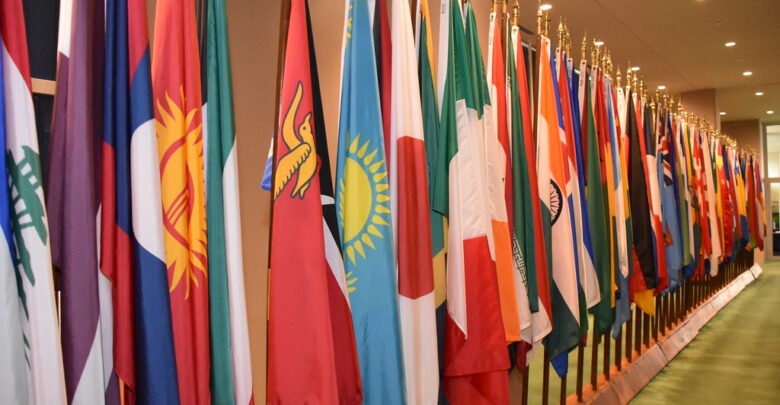United Nations: Mission, Founder, Headquarters & Organizational Chart

The United Nations, or U.N. as it is more generally known, is an international nonprofit group established in 1945 with the goal of fostering greater political and economic cooperation among its member nations.
The United Nations’s Mission
After World War II, the United Nations was established in order to calm international tensions, advance human rights, and lessen the likelihood of future major wars.
It is the replacement for the League of Nations, an organization for international cooperation established in 1920 following World conflict I but unable to stop conflict from breaking out in Europe and Asia in the 1930s.
The US didn’t sign up for the League of Nations.
The United States is one of practically all nations represented in the U.N. today (the organization’s headquarters are in New York City). Several nations don’t belong to the U.N., yet some of them do have de facto sovereignty.
In other instances (such as Kosovo and Taiwan), it is because one or more influential member nations have prevented their admission.
UN Organizational Chart
There are five main organizations that make up the United Nations: the General Assembly, Secretariat, International Court of Justice, Security Council, and Economic and Social Council. The U.N. Trusteeship Council, the sixth, has been dormant since 1994.
Who Was the United Nations Founder?
Representatives of 50 war-weary nations assembled in San Francisco, California, in April 1945 as World War II was nearing to an end for the United Nations Conference on International Organization.
The group spent two months building the United Nations, an international body that they all anticipated would contribute to the avertance of future global wars.
China, France, the Soviet Union, the United Kingdom, and Japan all approved the charter. The U.N. got off the ground officially on Oct. 24, 1945.
Headquarters for the United Nations
The headquarters of the United Nations (UN) are located in Midtown Manhattan in New York City, New York, in the United States. Since it was finished in 1951, the building has operated as the UN’s official headquarters.
The complex is made up of a number of buildings, including the Dag Hammarskjöld Library, the Secretariat, Conference, and General Assembly buildings.
Also Read: Aliko Dangote: The Richest Man in Africa & the Richest Black Man in the World
Aliko Dangote: The Richest Man in Africa & the Richest Black Man in the World
What are the United Nations Countries
The United Nations is made up of 193 nations.
The United Nations now has 193 member countries. The UN General Assembly is made up of representatives from each member state. The list of people’s joining dates is as follows:
| U.N. Member State | Date of Admission |
| Afghanistan | 19 November 1946 |
| Albania | 14 December 1955 |
| Algeria | 8 October 1962 |
| Andorra | 28 July 1993 |
| Angola | 1 December 1976 |
| Antigua and Barbuda | 11 November 1981 |
| Argentina | 24 October 1945 |
| Armenia | 2 March 1992 |
| Australia | 1 November 1945 |
| Austria | 14 December 1955 |
| Azerbaijan | 2 March 1992 |
| Bahamas | 18 September 1973 |
| Bahrain | 21 September 1971 |
| Bangladesh | 17 September 1974 |
| Barbados | 9 December 1966 |
| Belarus | 24 October 1945 |
| Belgium | 27 December 1945 |
| Belize | 25 September 1981 |
| Benin | 20 September 1960 |
| Bhutan | 21 September 1971 |
| Bolivia | 14 November 1945 |
| Bosnia and Herzegovina | 22 May 1992 |
| Botswana | 17 October 1966 |
| Brazil | 24 October 1945 |
| Brunei Darussalam | 21 September 1984 |
| Bulgaria | 14 December 1955 |
| Burkina Faso | 20 September 1960 |
| Burundi | 18 September 1962 |
| Cambodia | 14 December 1955 |
| Cameroon | 20 September 1960 |
| Canada | 9 November 1945 |
| Cape Verde | 16 September 1975 |
| Central African Republic | 20 September 1960 |
| Chad | 20 September 1960 |
| Chile | 24 October 1945 |
| China | 24 October 1945 |
| Colombia | 5 November 1945 |
| Comoros | 12 November 1975 |
| Congo (Republic of the) | 20 September 1960 |
| Costa Rica | 2 November 1945 |
| Côte d’Ivoire | 20 September 1960 |
| Croatia | 22 May 1992 |
| Cuba | 24 October 1945 |
| Cyprus | 20 September 1960 |
| Czechia (Czech Republic) | 19 January 1993 |
| Democratic People’s Republic of Korea | 17 September 1991 |
| Democratic Republic of the Congo | 20 September 1960 |
| Denmark | 24 October 1945 |
| Djibouti | 20 September 1977 |
| Dominica | 18 December 1978 |
| Dominican Republic | 24 October 1945 |
| Ecuador | 21 December 1945 |
| Egypt [6] | 24 October 1945 |
| El Salvador | 24 October 1945 |
| Equatorial Guinea | 12 November 1968 |
| Eritrea | 28 May 1993 |
| Estonia | 17 September 1991 |
| Ethiopia | 13 November 1945 |
| Fiji | 13 October 1970 |
| Finland | 14 December 1955 |
| France | 24 October 1945 |
| Gabon | 20 September 1960 |
| Gambia | 21 September 1965 |
| Georgia | 31 July 1992 |
| Germany | 18 September 1973 |
| Ghana | 8 March 1957 |
| Greece | 25 October 1945 |
| Grenada | 17 September 1974 |
| Guatemala | 21 November 1945 |
| Guinea | 12 December 1958 |
| Guinea-Bissau | 17 September 1974 |
| Guyana | 20 September 1966 |
| Haiti | 24 October 1945 |
| Honduras | 17 December 1945 |
| Hungary | 14 December 1955 |
| Iceland | 19 November 1946 |
| India | 30 October 1945 |
| Indonesia | 28 September 1950 |
| Iran | 24 October 1945 |
| Iraq | 21 December 1945 |
| Ireland | 14 December 1955 |
| Israel | 11 May 1949 |
| Italy | 14 December 1955 |
| Jamaica | 18 September 1962 |
| Japan | 18 December 1956 |
| Jordan | 14 December 1955 |
| Kazakhstan | 2 March 1992 |
| Kenya | 16 December 1963 |
| Kiribati | 14 September 1999 |
| Kuwait | 14 May 1963 |
| Kyrgyzstan | 2 March 1992 |
| Lao People’s Democratic Republic | 14 December 1955 |
| Latvia | 17 September 1991 |
| Lebanon | 24 October 1945 |
| Lesotho | 17 October 1966 |
| Liberia | 2 November 1945 |
| Libya | 14 December 1955 |
| Liechtenstein | 18 September 1990 |
| Lithuania | 17 September 1991 |
| Luxembourg | 24 October 1945 |
| Madagascar | 20 September 1960 |
| Malawi | 1 December 1964 |
| Malaysia | 17 September 1957 |
| Maldives | 21 September 1965 |
| Mali | 28 September 1960 |
| Malta | 1 December 1964 |
| Marshall Islands | 17 September 1991 |
| Mauritania | 27 October 1961 |
| Mauritius | 24 April 1968 |
| Mexico | 7 November 1945 |
| Micronesia (Federated States of) | 17 September 1991 |
| Monaco | 28 May 1993 |
| Mongolia | 27 October 1961 |
| Montenegro | 28 June 2006 |
| Morocco | 12 November 1956 |
| Mozambique | 16 September 1975 |
| Myanmar | 19 April 1948 |
| Namibia | 23 April 1990 |
| Nauru | 14 September 1999 |
| Nepal | 14 December 1955 |
| Netherlands | 10 December 1945 |
| New Zealand | 24 October 1945 |
| Nicaragua | 24 October 1945 |
| Niger | 20 September 1960 |
| Nigeria | 7 October 1960 |
| Norway | 27 November 1945 |
| Oman | 7 October 1971 |
| Pakistan | 30 September 1947 |
| Palau | 15 December 1994 |
| Panama | 13 November 1945 |
| Papua New Guinea | 10 October 1975 |
| Paraguay | 24 October 1945 |
| Peru | 31 October 1945 |
| Philippines | 24 October 1945 |
| Poland | 24 October 1945 |
| Portugal | 14 December 1955 |
| Qatar | 21 September 1971 |
| Republic of Korea | 17 September 1991 |
| Republic of Moldova | 2 March 1992 |
| Romania | 14 December 1955 |
| Russian Federation | 24 October 1945 |
| Rwanda | 18 September 1962 |
| Saint Kitts and Nevis | 23 September 1983 |
| Saint Lucia | 18 September 1979 |
| Saint Vincent and the Grenadines | 16 September 1980 |
| Samoa | 15 December 1976 |
| San Marino | 2 March 1992 |
| Sao Tome and Principe | 16 September 1975 |
| Saudi Arabia | 24 October 1945 |
| Senegal | 28 September 1960 |
| Serbia [12] | 1 November 2000 |
| Seychelles | 21 September 1976 |
| Sierra Leone | 27 September 1961 |
| Singapore | 21 September 1965 |
| Slovakia [13] | 19 January 1993 |
| Slovenia [14] | 22 May 1992 |
| Solomon Islands | 19 September 1978 |
| Somalia | 20 September 1960 |
| South Africa | 7 November 1945 |
| South Sudan | 14 July 2011 |
| Spain | 14 December 1955 |
| Sri Lanka | 14 December 1955 |
| Sudan | 12 November 1956 |
| Suriname | 4 December 1975 |
| Swaziland | 24 September 1968 |
| Switzerland | 10 September 2002 |
| Sweden | 19 November 1946 |
| Syria [15] | 24 October 1945 |
| Tajikistan | 2 March 1992 |
| Thailand | 16 December 1946 |
| The former Yugoslav Republic of Macedonia [16] | 8 April 1993 |
| Timor Leste | 27 September 2002 |
| Togo | 20 September 1960 |
| Tonga | 14 September 1999 |
| Trinidad and Tobago | 18 September 1962 |
| Tunisia | 12 November 1956 |
| Turkey | 24 October 1945 |
| Turkmenistan | 2 March 1992 |
| Tuvalu | 5 September 2000 |
| Uganda | 25 October 1962 |
| Ukraine | 24 October 1945 |
| United Arab Emirates | 9 December 1971 |
| United Kingdom | 24 October 1945 |
| United of Republic of Tanzania [17] | 14 December 1961 |
| United States | 24 October 1945 |
| Uruguay | 18 December 1945 |
| Uzbekistan | 2 March 1992 |
| Vanuatu | 15 September 1981 |
| Venezuela | 15 November 1945 |
| Vietnam | 20 September 1977 |
| Yemen | 30 September 1947 |
| Zambia | 1 December 1964 |
| Zimbabwe | 25 August 1980 |
Countries that are not members of the United Nations
There are now 54 nations or territories that are not members of the UN:
Independent States that are not members of the UN
Palestine, Vatican City *
* Palestine was given the status of a non-member observer state on November 29, 2012.
It still hasn’t been accepted as a full member of the UN.





